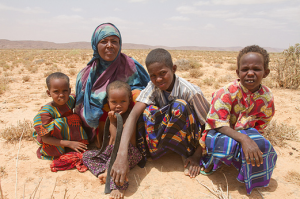Stolen aid not whole story of disaster response
Media focuses on what goes wrong, but bigger story is many things go right
by John Longhurst
As I read the article about stolen aid Somalia in various media websites this week, I thought: “Yep—right on schedule.”
And what schedule is that? Just as there are stages to a natural disaster, there are stages to how the media report about it.
Simply put, the stages of a natural disaster for international aid groups begin with discovery of the need, moves to respond and then, many months or years later, end with recovery — helping people address long-term food-security needs so they aren’t as severely impacted if another crisis hits.
The media follow a similar trajectory, beginning with the first alarming reports of dire need. What follows are the always-welcome encouragements for people to respond, along with stories of how people in need are being assisted. It then turns, with sad predictability, to stories about stolen or misappropriated aid.
And that is where we are at today.
According to the story from The Associated Press—which has been carried, to date, by more than 800 media outlets—thousands of sacks of food aid meant for Somalia’s famine victims have been stolen and are being sold at markets in the same neighbourhoods “where skeletal children in filthy refugee camps can’t find enough to eat.”
The story goes on to say the UN’s World Food Program acknowledged it has been investigating food theft in Somalia for two months, but that the scale of the famine crisis does not allow for a suspension of assistance.
The truth of the matter is that very little aid actually gets stolen—the vast majority of the assistance gets to those who need it. Any loss of food aid is regrettable; nobody wants to see it occur, least of all aid groups. But aid groups also know that things can go wrong, especially in places where security is lax or non-existent, when lawlessness abounds, corruption is rampant and where too many people have guns and aren’t afraid to use them.
As for aid for sale in markets, it’s not always what it seems. Some of it may indeed be stolen. But some of it may also have been sold by needy recipients in order to obtain cash to buy even more food or other kinds of food or other essential and needed items.
In aid parlance, this is known as a “resource transfer.” Needy people are still helped, albeit in a different way than intended.
When aid is stolen or is found for sale in the market, the media’s focus is usually on what’s gone wrong. But what’s more amazing is how much actually goes right, considering the incredibly difficult circumstances facing aid groups during emergencies like the one in eastern Africa. If you were planning to feed people, you probably wouldn’t plan to do it there, for so many, in a place where there’s no food, the roads are poor, housing is in short supply, conditions are harsh, and local authorities and systems are completely overwhelmed.
But that’s where they are, so it’s where aid groups need to be.
I don’t mean to dump on the media; without them, international aid groups would never be able to raise the amount of money needed to help people caught in crisis. They are vital to mobilizing Canadians to help people facing death or ruin in the developing world. Those of us who work in international relief and development deeply appreciate their help.
But articles like the one about stolen aid can also have the sad effect of dampening Canadian enthusiasm for giving. And that would be truly unfortunate.
Nobody wants to see aid stolen—aid groups least of all. They work hard to ensure that donations get to those who need help. This means planning for every contingency, including loss. They don’t like it, but they know they can’t stop helping the most vulnerable because some of their aid went missing.
There are places in the world where donations would never be stolen, lost or misappropriated—places where the government always works well, laws are enforced and respected, roads are in great condition, there is no war or conflict, housing isn’t an issue, and people feel secure.
The last time I checked, though, a country like Switzerland doesn’t need any food aid.
John Longhurst directs Resources & Public Engagement for Canadian Foodgrains Bank of which Canadian Lutheran World Relief (CLWR) is a member on behalf of Lutheran Church–Canada. To support CLWR’s work in the African food crisis, go to www.clwr.org/donate.






